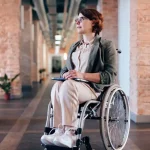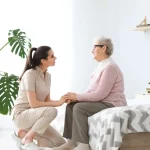Precautions for Using Oxygen Safely at Home
Are you a caregiver for someone using oxygen tanks or cylinders at home? If so, you probably have been told about some very important rules about using oxygen safely at home.
Oxygen safety is crucial for those undergoing oxygen therapy, and it is important to take precautions to ensure safe use of oxygen equipment and devices.
Rules like, “no smoking in the house” are vital for the safe use of supplemental oxygen.
This means, NO ONE should smoke: not the patient, not the caregiver, and no other family members or visitors.
Post a NO SMOKING sign on your door. There are many other precautions to take when you are using an oxygen cylinder or tank at home.
More Rules about using oxygen cylinders
Patients using oxygen should not use petroleum-based creams and lotions on their faces or upper parts of the body without permission from a respiratory therapist or doctor first.
Use water-based products only.
Do not use anything flammable while using your oxygen, including cleaning fluid, gasoline, paint thinner, aerosols or alcohol-containing sprays.
Keep oxygen at least five feet away from flames or heat sources, including gas stoves, barbecue grills, space heaters, fireplaces and candles. Oxygen is a safe gas, however, it is important to follow safety precautions to prevent accidents.
Oxygen can support combustion and make fires burn much faster and hotter.
Avoid causing any spark around the oxygen tank, particularly sparks from electric heaters, electric blankets, electric razors, hair dryers or friction toys.
Store oxygen tanks and cylinders upright in a well-ventilated space and make sure they are turned off.
Wheelchair Users and Oxygen
If you care for a patient in a wheelchair who uses oxygen, then you should be aware of a few other safeguards. Get prepared to use the oxygen cylinder by reading the instruction manual or asking your oxygen supplier about safe use.
Know how to turn it off, on, and how to use the tubing and cylinder carrier. Caregiver-Aid offers two different types of oxygen cylinder holders.
Going places
First, before you and the patient using the wheelchair go out for a while, be sure that you have enough oxygen in your cylinder before you get ready to go.
You should only use a portable oxygen cylinder when using a wheelchair; that big tank that was delivered to your home is far too large to carry around.
Transfer into the wheelchair before placing an cylinder carrier and the oxygen cylinder behind on the back. You do not want to tip over the empty wheelchair.
Mount the oxygen cylinder in a carrier on the back of the wheelchair securely. Do not hang other things or equipment on the back of the wheelchair; you don’t want to weight down the chair, or cause it to tip over.
Test the stability of the wheelchair to make sure that the wheelchair can bear the weight of both patient and oxygen cylinder. Be careful when wheeling up or down slopes, like ramps. The weight of the cylinder attached to the wheelchair might cause the wheelchair to slip and slide on steep slopes.
Do not allow the patient to carry the oxygen cylinder in his lap or in his arms. Do not cover the cylinder with a coat or blanket or other things. Covering the cylinder with such things can block air flow and cause a build-up of oxygen in one area.
Ensure that the oxygen tubing is kept safely away from moving parts of the wheelchair, so tubing will not be pinched or blocked.
When you get out of the wheelchair, remove the cylinder first, so the wheelchair will not tip over when the patient is not in it.
Always remove the oxygen cylinder and store it safely when traveling in a car. The cylinder should not be left unsecured to roll around in the seat or trunk of the car.
Home Hazards around Oxygen Users
Stay at least five feet from any heat source in front of the wheelchair and behind it. Be careful to avoid backing into a gas stove top in the kitchen, a grill on the patio, a fireplace, or any heat source when you are using your oxygen cylinder.
If you or a technician is repairing or cleaning your wheelchair, take the oxygen cylinder away from the worksite. Never put oil or grease near the oxygen as it can be flammable.
It is important to follow the instructions of your health care provider and the American Lung Association when using oxygen. If you are using a portable oxygen concentrator, you should use it with the flow rate prescribed by your doctor.
Keep your oxygen equipment away from open flames and heat sources. Keep the oxygen at least five feet away from any heat source. If you are using liquid oxygen, store it in a well-ventilated area away from heat sources and open flames.
When traveling with oxygen, be sure to check with your oxygen supply company for specific safety guidelines. You should never use an extension cord with an oxygen concentrator or use it near water.
Always have a back-up oxygen source with you, in case your primary source runs out. If you use an oxygen concentrator, make sure it is plugged into a grounded electrical outlet.
In summary
Oxygen is a safe gas to use but it is important to follow safety precautions to prevent accidents. You should always follow the instructions of your health care provider and the American Lung Association when using oxygen.
Keep your oxygen equipment away from open flames and heat sources, and store your oxygen tanks and cylinders upright in a well-ventilated space. Be aware of potential hazards in the home, such as heat sources, and take precautions to avoid them when using oxygen.
Always be sure to have enough oxygen in your cylinder before leaving the house, and mount the cylinder securely on the back of the wheelchair when using it.
Remember to keep the oxygen tubing away from moving parts of the wheelchair and remove the cylinder before getting out of the chair to prevent tipping.
When traveling, the cylinder should not be left unsecured in the car.
Following these safety tips will ensure that you are using oxygen safely and effectively.

